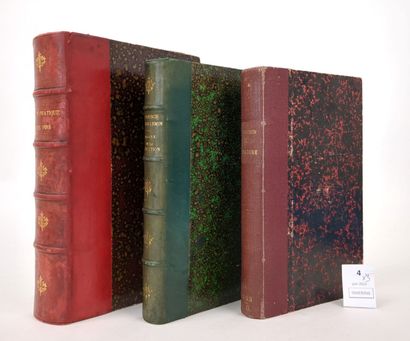Ensemble de trois figures en porcelaine modelées par Peter Strang représentant un jongleur, un cracheur de feu et une danseuse au serpent, Meissen, circa 1996-1997 Three Meissen figures modelled by Peter Strang depicting a juggler, a fire eater and a female snake dancer, circa 1996-1997The Juggler signed P Strang in gilding to back of base, the fire eater and snake dancer with a dedication on the base in gilding to Prof. Rafael, 25.5cm-29cm high, The Juggler: crossed swords mark in underglaze-blue, impressed model number 60603, impressed 26 C{?}, impressed 'von 11 Urstuecken No 2'; the Fire Easter: crossed swords mark in underglaze-blue, impressed model number 60602, impressed 1S; The Snake Dancer: crossed swords mark in underglaze-blue, impressed model number 60601, impressed 12 S (3)FootnotesPeter Strang (b. 1936) is considered one of the most important post-war artists working at Meissen. He says of himself "I always wanted to produce serious art, be ever so dramatic, like Lembruch or Barlach. But then everything (I made) turned out funny, although it wasn't meant to!" 'The material doesn't always do what you want it to, and sometimes it is better to simply listen to what it is saying to you. You start with something big and long, and you end up with something small and fat!' 'I never intended to stay this long at the factory, but the material just didn't want to let me go." After WWII, and after the founding of the DDR in 1949, the Meissen factory started up again. Initially it looked to the past for its modellers and approached Willy Münch-Khe and Paul Börner, but soon the management of the factory realised they needed a new artistic impulse and started buying models from independent artists, no doubt well-aware the same method had been employed successfully by Pfeiffer before the war. When the factory became more commercially viable a group of young, progressive artists became attached to the factory: the Kollektiv Künstlerische Entwicklung [collective for artistic development] included Rudi Stolle, Peter Strang, Heinz Werner and Ludwig Zepner. They followed in the footsteps of Scheurich, Esser and Börner and developed a new stylistic language in porcelain, still rooted in the traditions of the 250 or so preceding years. The best-known artistic output of this collective of artists is perhaps the 250-part Jagdservice [hunting service] of 1973, which was most recently exhibited at the Hetjens Museum in Düsseldorf (Märchenhaftes Meissen - Traumwelten der DDR, November 2019-April 2020).
Ensemble de trois figures en porcelaine modelées par Peter Strang représentant un jongleur, un cracheur de feu et une danseuse au serpent, Meissen, circa 1996-1997 Three Meissen figures modelled by Peter Strang depicting a juggler, a fire eater and a female snake dancer, circa 1996-1997The Juggler signed P Strang in gilding to back of base, the fire eater and snake dancer with a dedication on the base in gilding to Prof. Rafael, 25.5cm-29cm high, The Juggler: crossed swords mark in underglaze-blue, impressed model number 60603, impressed 26 C{?}, impressed 'von 11 Urstuecken No 2'; the Fire Easter: crossed swords mark in underglaze-blue, impressed model number 60602, impressed 1S; The Snake Dancer: crossed swords mark in underglaze-blue, impressed model number 60601, impressed 12 S (3)FootnotesPeter Strang (b. 1936) is considered one of the most important post-war artists working at Meissen. He says of himself "I always wanted to produce serious art, be ever so dramatic, like Lembruch or Barlach. But then everything (I made) turned out funny, although it wasn't meant to!" 'The material doesn't always do what you want it to, and sometimes it is better to simply listen to what it is saying to you. You start with something big and long, and you end up with something small and fat!' 'I never intended to stay this long at the factory, but the material just didn't want to let me go." After WWII, and after the founding of the DDR in 1949, the Meissen factory started up again. Initially it looked to the past for its modellers and approached Willy Münch-Khe and Paul Börner, but soon the management of the factory realised they needed a new artistic impulse and started buying models from independent artists, no doubt well-aware the same method had been employed successfully by Pfeiffer before the war. When the factory became more commercially viable a group of young, progressive artists became attached to the factory: the Kollektiv Künstlerische Entwicklung [collective for artistic development] included Rudi Stolle, Peter Strang, Heinz Werner and Ludwig Zepner. They followed in the footsteps of Scheurich, Esser and Börner and developed a new stylistic language in porcelain, still rooted in the traditions of the 250 or so preceding years. The best-known artistic output of this collective of artists is perhaps the 250-part Jagdservice [hunting service] of 1973, which was most recently exhibited at the Hetjens Museum in Düsseldorf (Märchenhaftes Meissen - Traumwelten der DDR, November 2019-April 2020).

.jpg)





.jpg)






.jpg)
Testen Sie LotSearch und seine Premium-Features 7 Tage - ohne Kosten!
Lassen Sie sich automatisch über neue Objekte in kommenden Auktionen benachrichtigen.
Suchauftrag anlegen